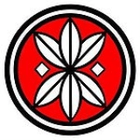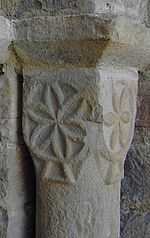Odinist Community of Spain — Ásatrú
 | |
| Formation | 1981 |
|---|---|
| Type | Odinist, Asatruar, Vanatruar (Heathenism) |
| Location | |
Membership | 400[1] |
Founders | Ernesto García, Isabel Rubio |
| Website | http://www.asatru.es/ |
The Odinist Community of Spain — Ásatrú (Spanish: Comunidad Odinista de España-Asatru), also known as European Odinist Circle (Spanish: Círculo Odinista Europeo, COE) is a Germanic Neopagan organisation in Spain founded in 1981 for followers of the denominations of Paganism known as Odinism, after the chief god of Germanic paganism, Odin, Ásatrú and Vanatrú. The community bases its ideology on the Visigothic heritage of modern Spain, Portugal and Occitania; it was legally recognised by the Spanish government in 2007.
Odinism

The term Odinism was coined by Orestes Brownson in his 1848 Letter to Protestants.[2] The term was re-introduced in the late 1930s by Alexander Rud Mills in Australia with his First Anglecyn Church of Odin and his book The Call of Our Ancient Nordic Religion. In the 1960s and early 1970s, Else Christensen's Odinist Study Group and later the Odinist Fellowship brought the term into usage in North America. Odinists do not necessarily focus on the worship of Odin and most honour the full pantheon.
Ásatrú is an Old Norse compound word derived from Áss or Ása, which refers to the Ases (one of the two families of gods in Norse paganism, led by Odin; the other being the Vanir), and trú, literally "troth" or "faith". Thus, Ásatrú is the "Faith of the Ases"). Vanatrú is coined after Ásatrú, implying a focus on the Wanes (the other family of gods in Norse mythology) rather than the Ases.
History
Under the influence of Christensen's group, Ernesto (or "Ernust") García and Isabel Rubio founded the "Spanish Odinist Circle" (Circulo Odinista Español) in Spain in 1981. Else Christensen gave her blessing to this organization and recognized it as such in 1981.[3] In 2007 the organization changed its name to "European Odinist Circle" (Círculo Odinista Europeo) after years of intense struggle for the restoration of Odinism.
In 2006 the COE began a fight against the pillaging in the ancient capital of the Visigoths, Toledo. Pressure was made on the regional president Jose Maria Barreda, and the COE obtained the stop of the destruction of the Visigothic remains. Those remains were in the entire Goth city with all its houses, streets, and monuments, and have been declared a national monument thanks to the effort of all.[4]
In 2007, the COE went from being a cultural organization to be officially recognized by the Spanish government as an official religious organisation under the name of Comunidad Odinista de España-Asatru,[5] allowing them to perform "legally binding civil ceremonies" (weddings). COE has been the fourth Odinist and Asatruar religious organization to have been recognized with official status in the world, after organisations in Iceland, Norway and Denmark.
In 2010, it was officially requested the declaration of "Notorio arraigo", OCSA is the first polytheistic religious denomination established in Spain which to claims it, in order to equate the legal level with other religions. In 2014, a census of members is done by Odinist Community and the number rise up to 10,000 members[6] is reached, having fully presence over the whole country.
Structure
The structure consists of the Reiki or president, who is the main social and religious figure in the COE. The priestly order Halirunae (in spanish: Orden Sacerdotal Halirunae) is composed of the godar and the seider. The seider office is divided into the spaekona, who perform spae magic and the seidkona who perform seid magic, which relates and unites the functions of völva, clairvoyance and high magic. Any person, male or female, may belong to these two offices. Member of the seider must also possess other types of power such as clairvoyance, telepathy. Since 2007 the godar have been governed by Godi Angel Arroyo and since 2008 the order of seider by Seidkona Maria Angeles Lozano. In late 2008, was appointed Ernust president, a position he currently combines with that of Godi. In June 2011, during the Althing held it was decided to appoint Angie Hervör as gyðja, and y Maria Luisa Olmeda (Meskala) as seidkona. Angie Hervör and Meskala lead a major split in Madrid, left the confession in 2013 and founded Asatru Lore Vanatru Assembly (ALVA). Today the priestly order is under reconstrution.
Beliefs

The code of values of the Odinist religion is to live in accordance with the Nine Noble Virtues and the Nine Programmatic Points of the COE.[7]
| Nine Noble Virtues of Odinism |
|---|
| 1. Courage |
| 2. Truth |
| 3. Honour |
| 4. Fidelity |
| 5. Discipline |
| 6. Hospitality |
| 7. Self-Reliance |
| 8. Industriousness |
| 9. Perseverance |
| Nine Programmatic Points of COE |
|---|
| 1 - Odinism, our ancestral religion in Europe. |
| 2 - The religion of the future. |
| 3 - The Gods and the sacred. |
| 4 - A code of values as a vital livelihood. |
| 5 - Odinism as a lifestyle. |
| 6 - The world, man, soul and body. |
| 7 - Respect for diversity. Fight for identity. |
| 8 - Religion, politics and society. |
| 9 - Everything perishes, everything returns to be. |
The Odinist Community of Spain is also studying carefully the works of Rupert Sheldrake on morphic fields and Carl Jung's works on collective unconscious as "very close to the Germanic ideas surrounding the Well of Urth". The organisation presents a definition of "metagenetics" as "the hypothesis that there are spiritual or metaphysical implications to physical relatedness among humans which correlate with, but go beyond, the known limits of genetics" (as defined by the American Asatruar Stephen McNallen).
Specifical holy days
- January (Snowmoon)
- January 21: Day of the founding of the Spanish Odinist Circle.
- April(Grasamenoþs)
- 1st full moon after the vernal equinox, Ostara festival. It represents the beginning of life after winter, where light and life back to the souls of men.
- May (Merrymoon)
- May 1: Walpurgis Night. Shamanic ceremony where Odin is represented by self-sacrifice in the great world tree, Yggdrasil.
- May 4: Remembrance Day for Else Christensen. Mother of Odinism who died May 4, 2005.
- June (Sunnamenoþs)
- June 21 Summer Solstice. Festival to honor the god Balder.
- September (Shedding)
- 2nd Saturday of September: Day of Odinism. National Encounter of the whole Confession Odinism, when a special blot to the gods and Confession Odinism is performed.
- October (Wintrufulliþs)
- October 16: Day of Vidarr. Vidarr is the God of silence and revenge. Day of remembrance for the martyrs.
- November (Fruma Jiuleis)
- November 1: Day Heimfall / Samhain. Feast where death and life are separated by a line so thin, you can pass in both directions through shamanic rituals.
- December (Afra Jiuleis)
- December 21: Yule. Festival consisted of 12 days after the Winter Solstice. The most important for Odinism, represents the victory of Sun over the darkness. It's time to make solemn oaths and special festivals of the god Freyr.
Wedding
On December the 23rd of 2007 the first legal Pagan wedding in Spain in 1500 years took place on the beaches of Vilanova, Barcelona.[8] "Jordi" and "Francesca", members of the Odinist Community of Spain, united their lives under the Continental Odinist Rite led by Ernust, godi of the COE. The ceremony was attended by pagans of all faiths in Spain, as well as members of the COE, leaders of the "Ancient Religious Society of Kelt", members of the Wiccan "Silver Willow Coven" and the Pagan Federation.
Temple

One of the pillar projects of the new odinist project is to build a temple. An ancient building located in a town of Albacete with a long history related to the ancestors of the town was relatively recently legally acquired and is currently being rebuilt since mid-2005. It is constructed in accordance with the old standards and consists of three halls:
- 1.- Hall devoted to the Aesir.
- 2.- Hall devoted to the Vanir.
- 3.- Shields hall, used for celebrations.
The temple bulding was completed in 2009, duly consecrated and the very first of its kind in the world.[9]
See also
Notes
- ↑ Disciples of Odin in Albacete
- ↑ The Works of Orestes A. Brownson: Containing the Second Part of the Political Writings, ed. Henry Francis Brownson, T. Nourse (1884), p. 257
- ↑ Else Christensen
- ↑ Gothic City
- ↑ Register of the minority religions of the Spanish Ministry of Justice
- ↑ Revista de Estudios Alicantinos
- ↑ Puntos programáticos del COE
- ↑ Disciples of Odin in Albacete
- ↑ Religious minorities in Castilla la Mancha
References
- Hernando de Larramendi, Miguel y García Ortiz, Puerto Minorías religiosas en Castilla-La Mancha Fundación Pluralismo y Convivencia y la Universidad de Castilla-La Mancha, Icaria editorial. see p. 311 ISBN 978-84-9888-025-0 (Spanish)
- Ernust García (2015),Encuentro con Odin: Un Ensayo Sobre el Destino, Biblioteca de Estudios Odinistas, ISBN 978-1-5085-4474-6 (Spanish)